| About Us | Contact Us | Contact Database | Support Us |
- MANUAL-
3.2.
Electrical and Mechanical Devices
There is direct correlation
in energy consumption and economic status of a country or region. The energy
for economic activities has to be in a form to provide mechanical output,
which can be used for production of certain items. As most of the production
units use electrical energy, several systems have been developed to harness
sustainable energy from sun, water, biomass, and wind. Some of the sustainable
energy technologies developed to produce electricity have matured and several
modules of these are available in the market, such as solar photovoltaic
systems, micro-hydro, biomass based power generation systems, and windmills.
Some of these technologies such as windmills can also be used directly
for mechanical output without converting it into electrical energy. Under
each type of sustainable energy, some selected technologies, which are
suitable for small households for economic up-liftment or simply for their
household needs are described here.
Considerable work has been done by research institutions to harness the
sustainable energy in the form of animal and human power that is grouped
under broad category of “animate energy”. Apart from agricultural
work, animate energy has been traditionally used for various mechanical
outputs such as for threshing, grinding, oil expelling, drawing water,
etc. However, systems to harness animal power for electricity generation
have not been matured as yet and require lot more work. Treadle pump,
which utilizes human power efficiently for pumping water from shallow
wells,
has been popular in Bangladesh and some parts of India, in Gangatic belt.
The electrical form of energy is also important for education, entertainment
and other household cores apart from economic point of view. However, a
large population is either completely deprived of this in South Asian villages
or receive irregular supply of the same. It is therefore necessary to not
only strive for producing electricity but also ensure electricity conservation
in urban areas. Some of the electricity conservation tips have also been
mentioned in this section.
3.2.1 Solar Photovoltaic Systems
In solar photovoltaic (SPV) technology, the solar radiation falling
on a device called solar cell is converted directly into electricity
without
any environmental pollution. Photovoltaic (PV) or solar cells as they
are often referred to are semiconductor devices that convert sunlight
into
direct current (DC) electricity. Groups of PV cells are electrically
configured into modules and arrays that can be used to charge batteries,
operate motors,
and to power any number of electrical loads.
With the appropriate power conversion equipment, PV systems can produce
alternating current (AC) compatible with any conventional appliances,
and operate in parallel with and interconnected to the utility grid.
Although a PV array produces power when exposed to sunlight, a number
of other components are required to properly conduct, control, convert,
distribute,
and store the energy produced by the array.
Depending on the functional and operational requirements of the system,
the specific components required, and may include major components such
as a DC-AC power inverter, battery bank, system and battery controller,
auxiliary energy sources and sometimes the specified electrical load
(appliances). In addition, an assortment of balance of system (BOS) hardware,
including wiring, over current, surge protection and disconnect devices,
and other power processing equipment.
SPV pumping systems are ideal for lifting water for drinking and irrigation
without harming the environment. These pumps can be installed in boreholes,
tanks, cisterns or rivers. DC surface pumps are designed for high flow
rates at low heads. DC floating pumps are suitable for wide range of
flow and head situations.
Applications:
- Telecommunications: to power satellites, remote transmitting stations, radio and TV sets, and telephone booths.
- Transport applications: to power car parking meters, automatic lawn movers, boats, future electric vehicles and in car parks with solar charging trees.
- Refrigeration: to power refrigerators in remote hospitals and health centres, mobile refrigerators to transport blood samples and medicine in desert areas, ice cream carts, etc.
- Lighting: to provide street lighting, standalone home lighting systems, and to charge solar powered lanterns.
- Water pumping: to provide clean water for drinking and washing, water for fish farming, animal farming, drip irrigation and large scale irrigation systems. This method of irrigation is ideal for cultivation of arid zones next to deserts for food production, and tree plantations in order to prevent desertification
- Large-scale power generation: through connecting solar roofs and solar farms to the national grid.
Benefits:
- Free and unlimited supply of power for basic requirements such as lighting and the use of radio and television in remote areas. This improves the quality of life.
- Better lighting systems increase opportunities for education and income generation activities, and it may enable schools and businesses to access computer facilities in non-electrified villages.
- Helps in pumping water for drinking, irrigation, washing and fish farming, thereby increasing the production of food.
- The large-scale power generation using solar farms and solar roofs will feed the national grid without CO2 emission. This energy can be used for industry and other applications during the daytime saving fossil fuels or water in reservoirs.
- The use of freely available solar energy to produce hydrogen from freely available water as a clean fuel of the future.
Disadvantages:
- Reliability depends on sunlight; back up is, therefore, necessary.
- Energy is available during daytime only, and thus storage facilities are required for many applications.
- Costs need to be further reduced via scientific research and development for rapid market penetration, although photovoltaic technologies are already economically viable for remote and standalone applications.
- Recycling facilities should be established in order to prevent any contamination from toxic elements in batteries and other solar equipments.
A Solar Photovoltaic Lantern is a lighting system consisting of a lamp battery and electronics all placed in a suitable housing made of metal, plastic or fiberglass and a PV module. The battery is charged by electricity generated through the PV module. The lantern is basically a portable lighting device suitable for either indoor or outdoor lighting covering a full range of 360 degrees. A lighting device that provides only unidirectional lighting will not be classifies as a solar lantern in the present context.
 A Solar lantern is a simple application of solar photovoltaic
technology, which has found good acceptance in rural regions where
the power supply is irregular and scarce. Even in the urban areas
people prefer a solar lantern as an alternative during power cuts
because of its simple mechanism. It is made of three main components:
the solar PV panel, the storage battery and the lamp. The operation
is very simple.
A Solar lantern is a simple application of solar photovoltaic
technology, which has found good acceptance in rural regions where
the power supply is irregular and scarce. Even in the urban areas
people prefer a solar lantern as an alternative during power cuts
because of its simple mechanism. It is made of three main components:
the solar PV panel, the storage battery and the lamp. The operation
is very simple.
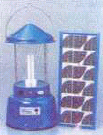 The solar energy is converted into electrical energy
by the SPV panel and
stored in a sealed maintenance-free battery for later use during
the night hours. A single charge can operate
the lamp for about 4-5 hours.
The solar energy is converted into electrical energy
by the SPV panel and
stored in a sealed maintenance-free battery for later use during
the night hours. A single charge can operate
the lamp for about 4-5 hours.
The solar lantern should provide a minimum of 3 hours of lighting
per day under average daily solar radiation conditions of 5 kWh/m2
on a horizontal surface. Solar panel is guaranteed to work for
15 years without any trouble. The actual duration of lighting may
vary depending on the location, season, etc. Average costs of the
solar lantern vary from Rs. 4500 to Rs. 7500.
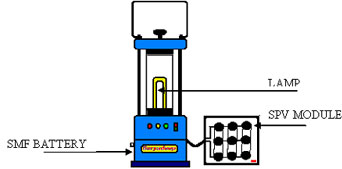
The solar lantern consists of a small photovoltaic panel to capture
and convert sunlight into direct current (DC). The DC is used
to charge a sealed maintenance free acid battery using a charge
controller. Whenever light is required the DC is inverted and
fed to a compact florescent
lamp of7-9 Watt rating.
3.2.1.2 Solar Home Systems (SHSs)
Solar home systems (SHS) are a popular use of solar energy. A solar
PV module and a battery provide basic electricity for single
households. The module is typically between 20 Watt and 100 Watt
and the battery between 30 and 150 Ah. In addition a charge controller
and DC low voltage wiring is needed. The electricity is used
for light, radio, small TV, charging of mobile phones and small
batteries, electric tools. Larger systems above 100 W can also
power an efficient refrigerator.
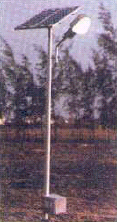 Compared with electric grid systems, SHS are quicker to install,
can be used almost everywhere, and are not plagued by power cuts.
On the other hand the electricity is limited to the capacity of
the panel and the battery, so the electricity has to be used with
care and high-powered equipment cannot be used, or can only be
used for a short time.
Compared with electric grid systems, SHS are quicker to install,
can be used almost everywhere, and are not plagued by power cuts.
On the other hand the electricity is limited to the capacity of
the panel and the battery, so the electricity has to be used with
care and high-powered equipment cannot be used, or can only be
used for a short time.
SHS are relatively expensive, and the electricity price is high
compared with grid-based electricity, though much lower than the
cost of electricity from dry batteries. If the grid is some distance
away from a house group or a small village, often SHSs are cheaper
than grid connections.
While a good PV panel can last for over 20 years, good batteries
(tubular, lead-acid, deep-charge batteries) can be charged
only 1200–2000 times, equal to 4–8 years of operation,
and only if they are well maintained and not overheated. Cheap
batteries
and car batteries have short lifetime
in solar installations, often
less than a year. A few cheap PV panels, mostly of the amorphous
type, have had short lifetimes of only 3-5 years, after which
the electricity production was only half of the original production.
Also the charge controller is a component that can fail, mostly
if it is overheated. A failure of a charge controller can lead
to destruction of the battery that it charges.
Because of the high costs of SHS some people have used one
SHS for both a family and a shop, or for two families. Also
income
generation activities are often combined with investment in
a SHS, such as working in the elecric light at night or selling
power
from the SHS to charge mobile phones.
This system has a battery large enough for a few cloudy days, and can give light for 4 hours/day. Some systems have smaller batteries and can only store the electricity from day to night.
3.2.1.3 Solar Street Light
Solar streetlight consists of two photovoltaic models of 36 Watts
each mounted on a 6 m lamppost for charging. At the base of pole
a box is provided which houses the charging system, a storage
battery and inverter unit. The unit is also provided with light
sensitive switch so that the street lamp gets lighted after sunset.
The panel captures sunlight during daytime and stores in battery
by using a charge controller.
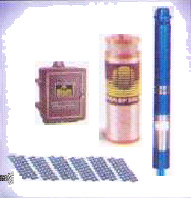 A solar photovoltaic water pumping system consists of a photovoltaic
array mounted on a stand, and one of the following motor-pump sets
compatible with the photovoltaic array. The photovoltaic array converts
the solar energy into electricity, which is used for running the motor
pump set. The pumping system draws water from the open well, bore well,
stream, pond, canal.
A solar photovoltaic water pumping system consists of a photovoltaic
array mounted on a stand, and one of the following motor-pump sets
compatible with the photovoltaic array. The photovoltaic array converts
the solar energy into electricity, which is used for running the motor
pump set. The pumping system draws water from the open well, bore well,
stream, pond, canal.The system components of solar photovoltaic water pumping system are: photovoltaic array, motor pump set, interface electronics, connecting cables and switches, support structure and tracking system, pipes, etc.
The SPV water pumping system is used in agriculture, horticulture, animal husbandry, poultry farming, high value crops, orchards, silviculture, fish culture, salt farming, drinking water, etc.
Water pumping systems are available in different types to meet various needs and applications:
- Surface Pumps: These pumps are suitable for lifting and pumping water from a maximum depth of 20 meters (total head).
-
Submersible Pumps: These pumps can be used in areas where water is available at a greater depth and where open wells are not available. The maximum recommended depth of these systems could be 50 meters.
-
Solar Hand Pumps: These pumps are exclusively designed by Balaji Industrial and Agricultural Castings to meet both the requirements of surface and submersible pumps. It has a manual operation mode where the system can be used manually once sufficient sunshine is not available to drive the pump.
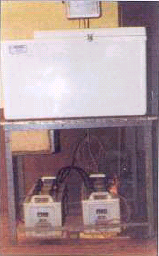
These pumps are used in village water supply, livestock watering, remote homes, micro-irrigation, homes, dispensaries and community centers, etc. A SPV water pumping system is available with a photovoltaic array of capacity in the range of 200 watts to 3000 watts (Capacity of motor pump set is from 0.5 hp to 2 hp).
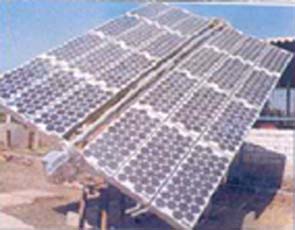
The system is expected to deliver a minimum of 65,000 liters per
day for a 900 watts panel and 135,000 liters per day for an 1800
watts panel from a suction head of 7 meters and/or a total head of
10 meters on a clear sunny day. In case of deep well submersible
pumps, the water output shall be a minimum of 45,000 liters from
1200 hp. The SPV water pumping system may command an area of irrigation
0.5-6 hectares at a total head of 10 meters depending on water table,
type of soil and water management.
Table.3.2 indicates critical irrigation
command area for different crops with the type of method used:
S. No. |
Crops |
Critical command area in ha |
Irrigation method |
1. |
Year round vegetables cultivation |
1.00 |
Surface |
2. |
Chillies/sorghum/ groundnut |
1.41 |
Surface |
3. |
Paddy nursery |
0.70 |
Surface |
4. |
Garlic |
2.08 |
Micro sprinkler |
5. |
Cucumber |
1.82 |
Drip |
6. |
Groundnut |
1.97 |
Micro sprinkler |
7. |
Grapes |
2.14 |
Drip |
8. |
Lime |
4.89 |
Drip |
9. |
Banana |
2.36 |
Drip |
10. |
Pomegranate |
7.32 |
Drip |
Subsidized cost of installation and commissioning of a SPV water
pumping system will vary between Rs. 1,90,000 to Rs.2,70,000
depending upon the supplier and model. Subsidy available is of Rs.110
per hp
subject to a maximum of Rs. 2,50,000 per pump set.
Solar PV modules have a long-lasting life of more than 20 years and
are absolutely maintenance free according to Balaji Industrial and
Agricultural Castings, who is one of the manufacturers.
3.2.1.5 Solar Tracking Device
Orienting a photovoltaic panel from the morning to evening to face the sun can increase its performance by up to 30%. The solar tracking device is designed to accurately track a solar panel fitted on a specially balanced frame. It has an electronic timer unit and a set of gears to transmit the power to the panel. Orientation is accomplished in small steps of 38 pulses per minute and its motion is almost imperceptible. Power for the tracking unit is obtained from one of the panels with a charge controller and small storage battery. At the end of the day, the frame closes a limit switch and the tracker is powered off. On the next day, the unit is disarrayed with the help of the clutch provided and oriented to face the sun. Thereafter, tracking takes place automatically for the whole day. Thus it needs attention only for a few minutes at the start of the day. Due to increased output, higher rating of load can be used with such panels.
3.2.1.6 Solar Photovoltaic Refrigerator
A solar photovoltaic refrigerator has been developed to keep vaccines, medicines and other perishables. A solar photovoltaic (SPV) panel of 180 Watt peak power along with a battery pack supplies the powers to the compressor unit. The unit is operated on direct current power supply and hence special compressor unit has been adopted. The unit has an opening on the top so that cold air doesn’t escape when it is opened for removing/replacing the product.


